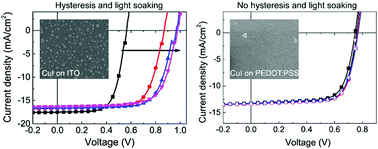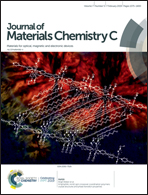Aging-induced light-soaking effects and open-circuit voltage hysteretic behavior of inverted perovskite solar cells incorporating a hole transport metal halide layer via morphology-dependent inflow of iodide ions†
Abstract
Light soaking and current density–voltage (J–V) hysteretic effects represent instability in the power output of organic–inorganic metal halide perovskite solar cells that exhibit promising potential in applications in the field of energy conversion. Ion migration/accumulation is known to be a key factor causing those effects, but the mechanisms to determine which accumulation region makes a more significant contribution need to be further elucidated. Copper iodide (CuI) has been diversely utilized as a hole-transport layer in solution-processed photovoltaic devices. In this work, for the first time, the power output instability that occurs seemingly at random with an incorporation of CuI in methylammonium lead triiodide perovskite solar cells is found to be, in fact, strongly aging- and CuI morphology-dependent. Light-soaking effects and hysteretic behavior particularly in the open-circuit voltage (Voc) appear differently for the fresh and aged devices. Device investigations with the aging time scale, electrical preconditioning, light intensity-dependent Voc, and scan rates demonstrate that the accumulation of iodide ions at the interface with an electron transport layer (PCBM) by the diffusive migration from the interface with CuI during aging is responsible for light soaking and hysteresis phenomena. Our study reveals which ion accumulation region may more significantly contribute to light soaking and hysteretic phenomena.



 Please wait while we load your content...
Please wait while we load your content...